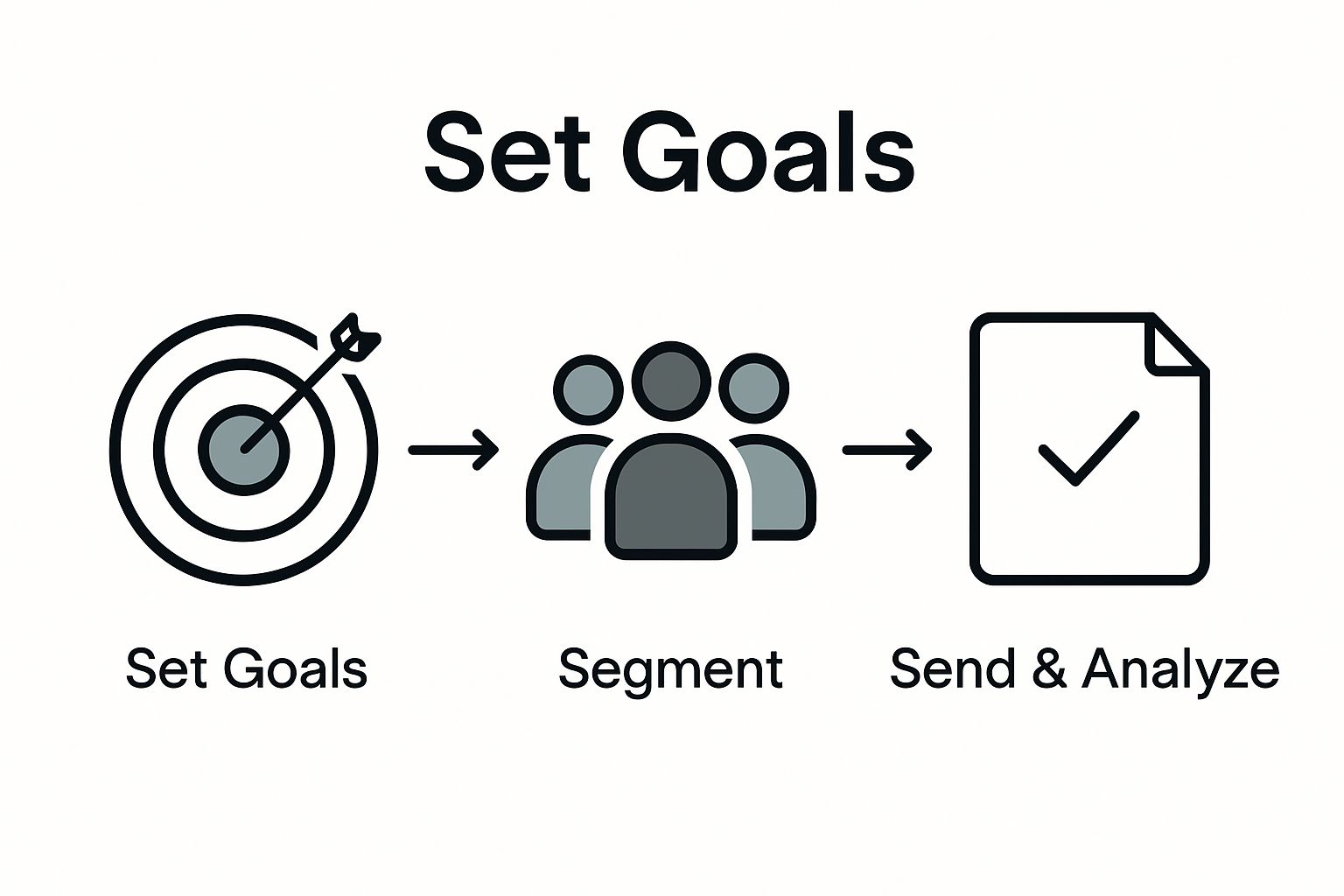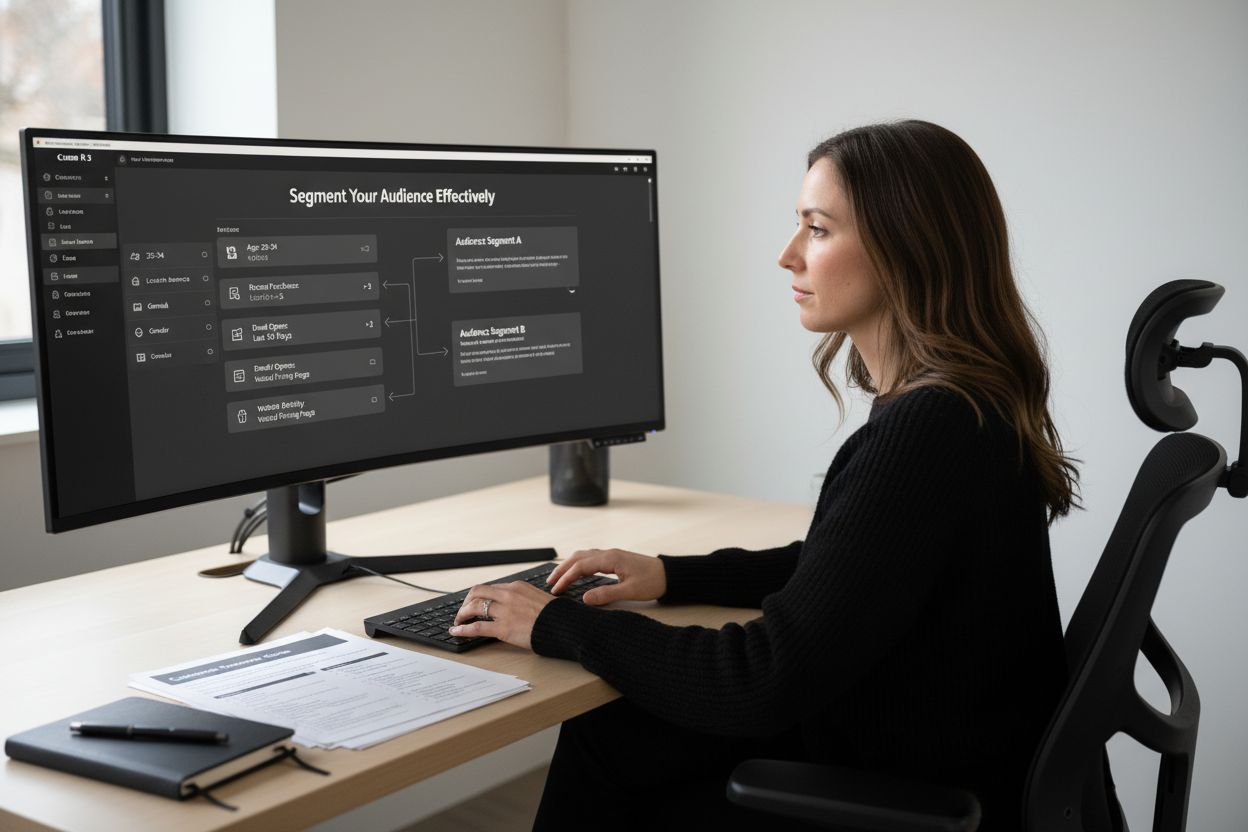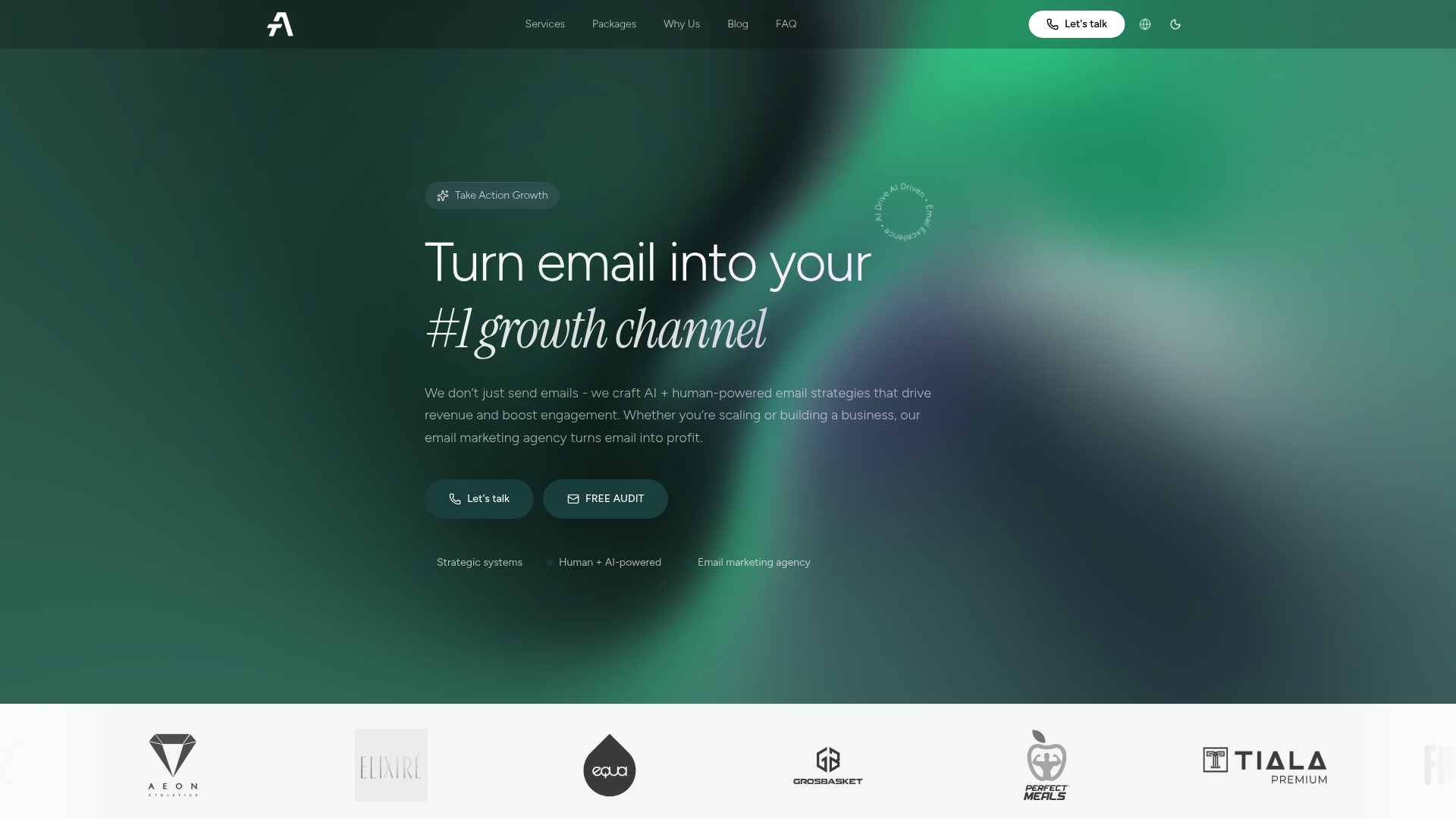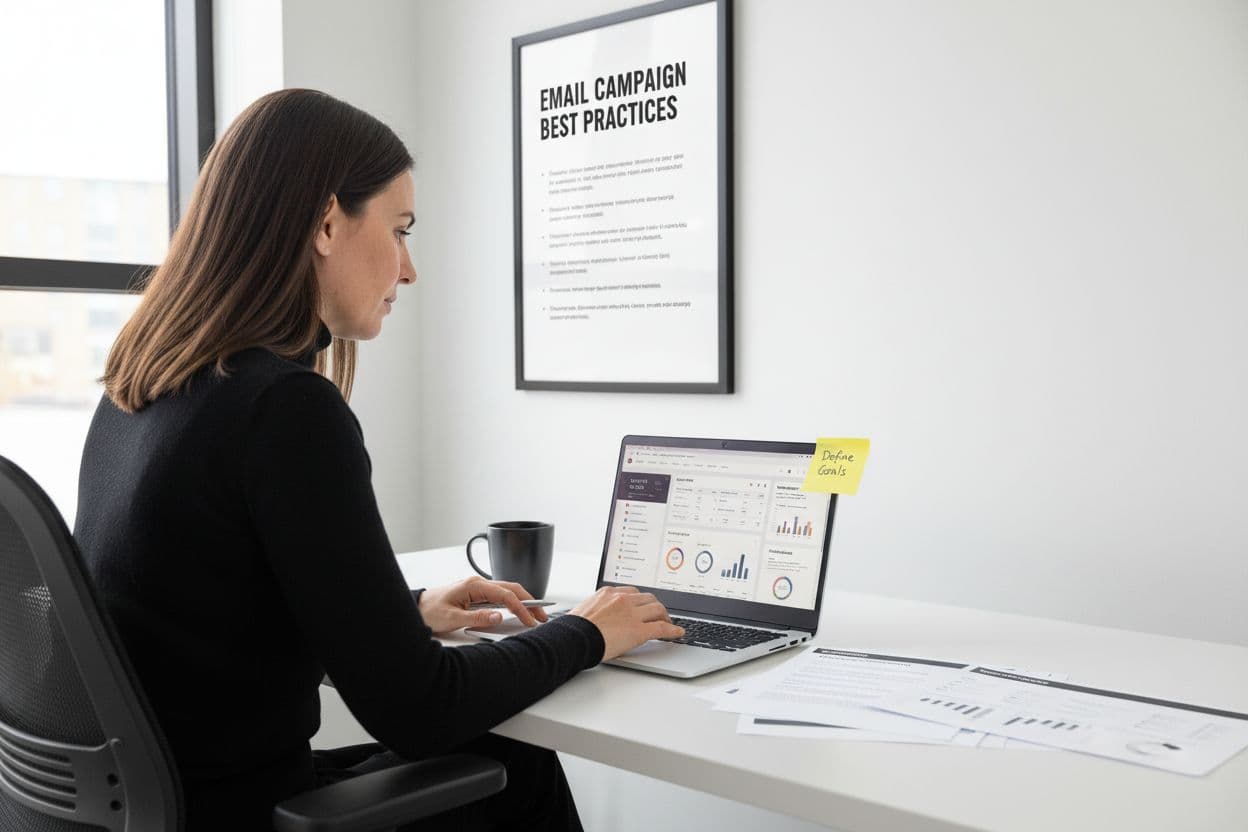Email Campaign Best Practices for 2025 Success
Email marketing might seem simple, just send a message and watch leads roll in, right? Brands using targeted email strategies have seen ROI rates as high as 4200 percent. Sounds like easy money. But the truth is, most email campaigns fizzle because they skip the strategy and chase quick wins. The real breakthrough comes from a tested formula that transforms scattershot emails into powerful, data-driven results.
Table of Contents
- Step 1: Define Your Campaign Goals
- Step 2: Segment Your Audience Effectively
- Step 3: Create Compelling Email Content
- Step 4: Optimize Your Send Time
- Step 5: Test And Analyze Campaign Performance
Quick Summary
| Key Point | Explanation |
|---|---|
| 1. Define clear campaign goals | Establish specific, measurable objectives for your email campaigns that align with your broader business outcomes. |
| 2. Segment your audience effectively | Use detailed data to create targeted audience segments that improve engagement and conversion rates significantly. |
| 3. Craft compelling email content | Develop personalized messages that resonate with specific customer needs, fostering emotional connections and prompting actions. |
| 4. Optimize email send times | Identify the best times to send emails for different audience segments to maximize open and engagement rates. |
| 5. Continuously test and analyze performance | Implement ongoing performance analysis and A/B testing to drive incremental improvements and optimize email strategies. |
Step 1: Define Your Campaign Goals
Successful email campaigns start with crystal clear objectives that transform scattered marketing efforts into precision-targeted strategies. Defining your campaign goals isn’t just about picking a random target but strategically mapping out exactly what you want to achieve and how you’ll measure success. The most effective email campaigns are born from intentional, data-driven goal setting that aligns with your broader business objectives.
When establishing campaign goals, focus on creating specific, measurable outcomes that directly contribute to your business growth. Are you aiming to increase customer retention, drive product sales, promote a new service, or re-engage dormant subscribers? Each goal requires a nuanced approach tailored to your unique audience and business model. For ecommerce brands, this might mean targeting a specific revenue increase from email marketing, while for service-based businesses, the goal could be booking more consultations or driving webinar registrations.
To craft precise campaign goals, start by analyzing your current email performance metrics. Review open rates, click-through rates, conversion rates, and revenue generated from previous campaigns. This historical data provides a baseline for setting realistic, achievable targets. Learn more about scaling your digital marketing strategies to understand how strategic goal setting can transform your email marketing approach.
Your goals should follow the SMART framework: Specific, Measurable, Achievable, Relevant, and Time-bound. Instead of a vague objective like “increase sales,” develop a precise goal such as “Generate $25,000 in additional revenue through targeted email campaigns within the next 90 days” or “Improve customer retention by reducing churn rate by 15% through personalized re-engagement email sequences.”
Remember that goal setting is an iterative process. Your initial objectives might need refinement as you gather more data and understand your audience’s behavior. Regularly review and adjust your goals to ensure they remain aligned with your evolving business strategy and market dynamics. By establishing clear, actionable goals from the start, you set the foundation for email campaigns that not only connect with your audience but drive meaningful business results.
Below is an overview table summarizing each step in an effective email campaign process, along with its objective and a key verification metric.
| Step | Objective | Key Verification Metric |
|---|---|---|
| Define Campaign Goals | Set clear, measurable goals aligned with business objectives | Specific targets (e.g., revenue goal, retention rate improvement) |
| Segment Audience | Create targeted groups using data for personalization | Increased engagement for each segment |
| Create Compelling Content | Develop engaging, relevant messages for each audience segment | Higher open and click-through rates |
| Optimize Send Time | Determine optimal timing to maximize engagement | Boosted open and conversion rates post-optimization |
| Test & Analyze Performance | Continuously refine campaigns using data and testing | Documented improvement in key performance indicators |

Step 2: Segment Your Audience Effectively
Audience segmentation transforms generic email campaigns into precision-targeted communication strategies that speak directly to specific customer groups. Effective segmentation goes beyond basic demographics, diving deep into behavioral patterns, purchase history, and engagement levels to create truly personalized experiences. By understanding the unique characteristics of different audience segments, you can craft messages that resonate more powerfully and drive significantly higher conversion rates.
Start by collecting comprehensive data about your subscribers through multiple touchpoints. Your email service provider and customer relationship management (CRM) systems are crucial tools in this process. Look beyond surface-level information like age and location. Analyze purchase frequency, average order value, product preferences, browsing behavior, and interaction history with previous email campaigns. Explore our in-depth guide on audience segmentation to understand the nuanced strategies that can elevate your email marketing approach.
Creating meaningful segments requires a strategic approach that considers multiple dimensions of customer behavior. For ecommerce brands, consider segmenting audiences based on criteria such as customer lifetime value, recency of purchase, product categories of interest, and engagement levels. A new customer segment might receive welcome series emails with introductory offers, while high-value repeat customers could get exclusive previews or loyalty rewards. Dormant subscribers might require a re-engagement campaign with compelling win-back incentives.
Technology plays a critical role in sophisticated audience segmentation. Modern email marketing platforms offer advanced segmentation tools that can automatically categorize subscribers based on complex criteria. Utilize these tools to create dynamic segments that update in real-time as customer behaviors change. Automated segmentation ensures your email campaigns remain relevant and responsive to your audience’s evolving needs.
Verify the effectiveness of your segmentation by tracking key performance indicators like open rates, click-through rates, and conversion metrics for each segment. A well-crafted segmentation strategy should show marked improvements in engagement and revenue compared to broad, undifferentiated email campaigns. Continuously refine your segments, testing different approaches and remaining adaptable to shifts in customer behavior and market dynamics.

Step 3: Create Compelling Email Content
Crafting email content that captures attention and drives action requires a strategic blend of creativity, psychology, and data-driven insights. The most successful email campaigns communicate value within seconds, transforming casual readers into engaged customers. Your content must do more than simply inform readers it must create an emotional connection that motivates them to take the next step.
Begin by understanding your audience segments deeply and tailoring your messaging to their specific needs and pain points. Each email should feel like a personalized conversation, not a generic broadcast. Explore our proven email sequence strategies to understand how targeted messaging can dramatically improve engagement rates. Use language that speaks directly to the reader’s desires, challenges, and aspirations. This means moving beyond product features and focusing on the transformative benefits your offering provides.
Structure your email content with a clear hierarchy that guides the reader’s eye and attention. Start with a compelling subject line that creates immediate intrigue or offers a clear value proposition. Your opening paragraph should quickly establish relevance, explaining why the reader should care about your message. Use concise, conversational language that feels authentic and avoids corporate jargon. Break up text with strategic white space, ensuring the email feels easy to digest and visually appealing across different devices and email clients.
Visual elements play a crucial role in email content effectiveness. Include high-quality images or graphics that complement your message and reinforce your brand identity. However, be mindful of image-to-text ratios and ensure your core message remains readable even if images are blocked. Dynamic content elements like animated buttons, subtle movement, or personalized product recommendations can significantly increase engagement and click-through rates.
To verify the effectiveness of your email content, track key performance metrics such as open rates, click-through rates, and conversion rates. A compelling email should demonstrate measurable improvements in these areas compared to previous campaigns. Continuously test different approaches, experimenting with subject lines, content styles, and visual designs to understand what resonates most with your specific audience segments. Remember that email content is an ongoing optimization process that requires consistent refinement and a willingness to adapt based on real-world performance data.
Step 4: Optimize Your Send Time
Email send time optimization represents a critical yet often overlooked element of successful email marketing campaigns. Sending emails at the right moment can dramatically increase open rates, engagement, and ultimately, conversion potential. Your goal is to identify precisely when your specific audience is most likely to interact with your email content, which requires a nuanced approach beyond generic time recommendations.
The complexity of send time optimization goes far beyond traditional assumptions about morning or evening email schedules. Different audience segments have unique behavioral patterns influenced by factors like industry, job role, personal schedules, and geographic location. Learn strategies to increase conversions through precise timing, which includes understanding the critical role of strategic email scheduling. Modern email marketing platforms offer sophisticated tools that analyze individual subscriber interaction histories, helping you pinpoint optimal send times for each recipient.
Begin your send time optimization journey by collecting granular data from your existing email campaigns. Most email service providers offer detailed analytics that track when subscribers typically open and engage with emails. Pay close attention to metrics like open rates, click-through rates, and conversion rates across different times and days. Look for consistent patterns within your specific audience segments. A technology professional might engage differently compared to a retail consumer, so segmentation becomes crucial in determining ideal send times.
Utilize advanced features like send time optimization algorithms available in platforms like Klaviyo, which automatically determine the best sending window for individual subscribers based on their historical engagement patterns. These intelligent systems analyze massive datasets to predict when each subscriber is most likely to open and interact with your email. However, don’t rely exclusively on automated tools. Continuously test and validate these recommendations by running periodic A/B tests that compare different send times and measuring their performance.
To verify the effectiveness of your send time strategy, establish clear performance benchmarks before implementation. Track key metrics like open rates, click-through rates, and conversion rates before and after optimizing send times. Significant improvements in these metrics indicate successful send time optimization. Remember that audience behaviors evolve, so what works today might change in six months. Commit to regular analysis and refinement, treating send time optimization as an ongoing process of strategic experimentation and data-driven decision making.
Step 5: Test and Analyze Campaign Performance
Testing and analyzing email campaign performance is the strategic cornerstone that transforms guesswork into precision marketing. Performance analysis is not a one-time event, but a continuous process of measurement, learning, and optimization that drives incremental improvements in your email marketing effectiveness. By systematically evaluating campaign metrics, you gain actionable insights that directly impact your marketing strategy and business outcomes.
Explore the critical role of marketing analytics to understand how data-driven decisions can revolutionize your email campaign approach. Start by establishing a comprehensive tracking framework that goes beyond surface-level metrics. While open rates and click-through rates provide initial insights, focus on deeper performance indicators like conversion rates, revenue per email, subscriber growth, and engagement segments. Modern email marketing platforms offer sophisticated analytics tools that can break down performance across different audience segments, helping you understand precisely how different groups interact with your content.
Implement a structured A/B testing methodology to continuously refine your email campaigns. This involves systematically testing individual elements like subject lines, email content, design layouts, call-to-action buttons, and send times. Create controlled experiments where you change only one variable at a time, allowing you to isolate the specific factor driving performance improvements. For instance, test two different subject lines with identical email content to understand which messaging approach resonates more strongly with your audience.
Track statistically significant results that provide meaningful insights rather than drawing conclusions from limited data points.
Develop a regular performance review cadence that allows for consistent analysis and strategic adjustments. Schedule monthly or quarterly deep-dive sessions where you comprehensively review campaign performance, comparing current results against historical benchmarks and industry standards. Look for emerging trends, unexpected patterns, and opportunities for optimization. Pay special attention to how different audience segments respond to your campaigns, as this can reveal nuanced insights about customer preferences and behaviors.
To verify the effectiveness of your testing and analysis process, establish clear performance benchmarks and improvement targets. Your analysis should consistently yield actionable insights that translate into tangible improvements in email campaign metrics. Successful performance analysis means you’re not just collecting data, but actively using those insights to refine your email marketing strategy. Remember that the goal is continuous improvement a perpetual cycle of testing, learning, and optimizing that keeps your email campaigns dynamic, relevant, and increasingly effective.
Use this checklist table to confirm that your campaign setup covers all essential completion criteria at each crucial stage of your email marketing process.
| Campaign Stage | Completion Criteria | Verified (Yes/No) |
|---|---|---|
| Goals Defined | SMART goals created with measurable targets | |
| Audience Segmented | Segments created based on behavior, purchase history, and engagement | |
| Content Crafted | Email content tailored to each segment and tested for clarity | |
| Send Time Optimized | Send times analyzed and A/B tested for key groups | |
| Performance Reviewed | Campaign results tracked, analyzed, and actionable insights documented |
Transform Your Email Challenges into Revenue Growth in 2025
Is your brand struggling to make sense of complex segmentation, optimize send times, and consistently convert subscribers into loyal customers? Many businesses waste countless hours on broad campaigns that fail to deliver while missing out on the revenue-driving potential of truly tailored email strategy. The insights in your latest guide showcase just how important it is to set precise campaign goals, deploy smart automations, and adopt data-driven analysis every step of the way. These are the exact pain points that kneecap ambitious growth and leave revenue untapped.

Take the guesswork out of your strategy by partnering with a dedicated email marketing agency that already lives and breathes these best practices. At Take Action, we use AI-powered tools and human expertise to automate your flows, fine-tune messaging, and maximize every touchpoint. From segmenting your audience more deeply to recovering abandoned carts and driving up click rates, our solutions are built for brands ready to scale. Ready to see how aligning your 2025 email goals with our proven approach can boost your results? Start your growth journey with Take Action today and experience what sophisticated, conversion-driven email campaigns can do for your business.
Frequently Asked Questions
What are the key objectives I should set for my email campaign in 2025?
To achieve success in your 2025 email campaigns, you should focus on setting specific, measurable goals like increasing customer retention by 15% or generating $25,000 in additional revenue. Start by analyzing past campaign performance metrics to inform realistic targets that align with your overall business objectives.
How can I segment my audience for more effective email campaigns?
Segment your audience by collecting detailed data on their behavior, purchase history, and engagement levels. Create distinct groups, such as new customers or dormant subscribers, to tailor your messaging accordingly and increase your conversion rates by at least 20%.
What type of content should I include in my email campaigns?
Craft personalized email content that addresses your audience’s specific needs and pain points. Focus on clear value propositions and compelling visuals to engage readers within the first few seconds of opening your email.
How do I determine the best time to send my emails?
Identify optimal send times by analyzing your audience’s past engagement metrics and testing different send times based on their historical behaviors. Aim to optimize your send time strategy to boost your open rates by at least 10% over the next few campaigns.
What metrics should I track to measure email campaign success?
Track key performance indicators such as open rates, click-through rates, conversion rates, and revenue generated per email. Reviewing these metrics regularly will help you identify trends and make data-driven adjustments to improve campaign performance.
How often should I test and analyze my email campaigns?
Implement a monthly review cadence for testing and analyzing your email campaigns to ensure continuous improvement. Focus on A/B testing individual elements, which can lead to improved engagement and conversion rates over time.
Recommended
- Personalized Email Campaigns: A Growth Guide for 2025 | Take Action Blog | Take Action
- 10 Creative Content Ideas for Newsletters to Boost Engagement | Take Action Blog | Take Action
- 7 Essential Lead Generation Techniques for 2025 | Take Action Blog | Take Action
- 7 Essential Ecommerce Marketing Strategies for Growth | Take Action Blog | Take Action
- Email Campaigns and SEO: Winning Strategies for 2025
